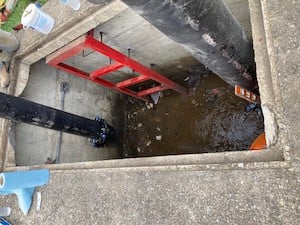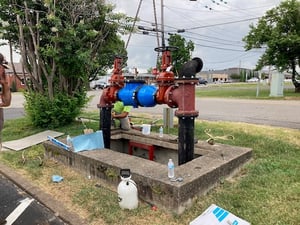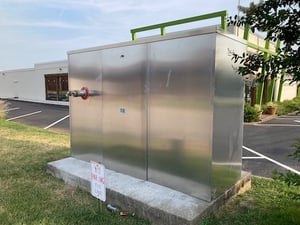 As more water jurisdictions realize the dangers of confined space vaults, they are bringing their backflows and meters aboveground. Sometimes you need to learn the hard way, as we stumbled upon a retrofit of a backflow that was once in a subterranean vault, now being brought above the surface.
As more water jurisdictions realize the dangers of confined space vaults, they are bringing their backflows and meters aboveground. Sometimes you need to learn the hard way, as we stumbled upon a retrofit of a backflow that was once in a subterranean vault, now being brought above the surface.
A costly design error, a dangerous backflow vault is backfilled with dirt and gravel and the new installation is safely above grade. This may seem a bit shocking to you, but here are the reasons why backflow vaults like this could soon be a thing of the past.
Restrictions on Enclosed Spaces: Many jurisdictions say changes to backflows have to happen aboveground. Any change order or repair permit for a below-grade backflow preventer often requires complete replacement to an above-ground installation. Confined spaces require OSHA permits, and the dangers to the workforce are just not worth the risk. In the situation we encountered, a simple repair required the entire installation to be moved aboveground. 
Ease of Maintenance and Backflow Repairs: Times change, and so do backflow preventer designs. Backflow preventers need maintenance, repair kits and replacement checks, and having them in vaults makes them difficult to service and labor-intensive.
Environmental Concerns - Flooded Backflow & Pump Vaults Causing Damage: Backflow vaults and cages may protect from vandalism, but they do little to protect from the elements, specifically flooding and water damage. In Florida and along the southeast coast, storm surges and sand can corrode metal backflow devices.
What we recently saw was a reminder of the many reasons why vaults are not the ideal choice for backflow preventers and meters. Besides the enormous cost of installation and the eventual retrofit to bring the entire installation above the surface, there are many safety benefits and cost-saving elements to above-ground enclosures, and lower risks involved. Here are more reasons to Think Outside the Vault.





